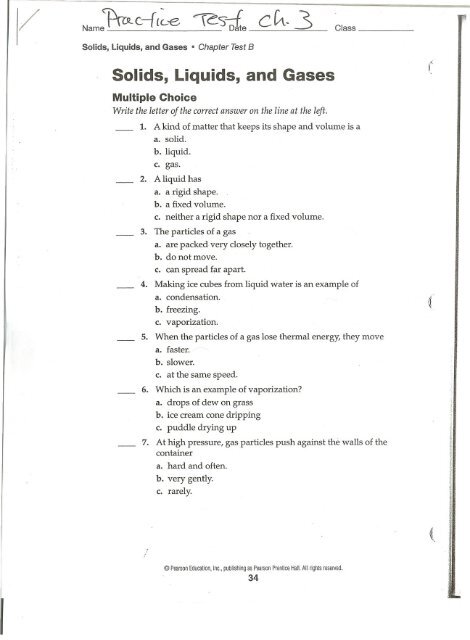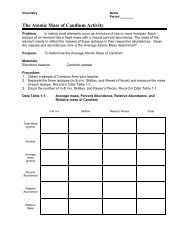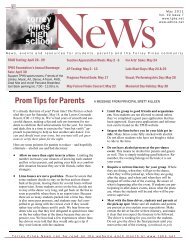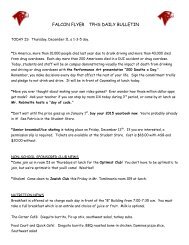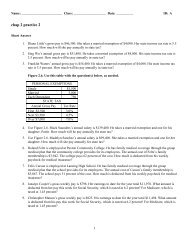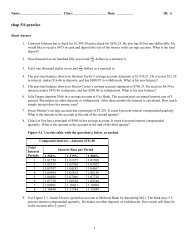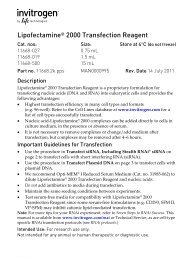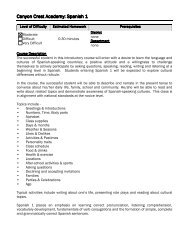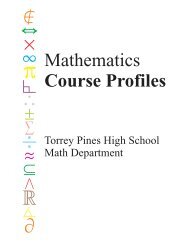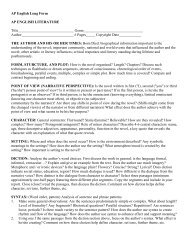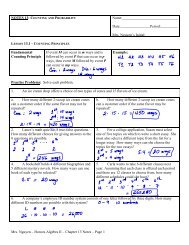Solids, Liquids, and Gases - Teacher
Solids, Liquids, and Gases - Teacher
Solids, Liquids, and Gases - Teacher
Create successful ePaper yourself
Turn your PDF publications into a flip-book with our unique Google optimized e-Paper software.
I<br />
/ Class<br />
<strong>Solids</strong>, <strong>Liquids</strong>, <strong>and</strong> <strong>Gases</strong><br />
· Chapter Test B<br />
<strong>Solids</strong>, <strong>Liquids</strong>, <strong>and</strong> <strong>Gases</strong><br />
Multiple Choice<br />
Write the letter of the correctanswer on the line at the left.<br />
1. A kind of matter that keeps its shape <strong>and</strong> volume is a<br />
a. solid.<br />
b. liquid.<br />
c. gas.<br />
2. A liquid has<br />
a. a rigid shape.<br />
b. a fixedvolume.<br />
c. neither a rigid shape nor a fixed volume.<br />
3. The particles of a gas<br />
a. are packed.very closelytogether.<br />
b. do not move.<br />
c. can spread far apart.<br />
4. Making ice cubes from liquid water is an example of<br />
a. condensation.<br />
b. freezing.<br />
c. vaporization.<br />
5. When the particles of a gas lose thermal energy, they move<br />
a. faster.<br />
b. slower.<br />
c. at the same speed.<br />
6. Which is an example of vaporization<br />
a. drops of dew on grass<br />
b. ice cream cone dripping<br />
c. puddle drying up<br />
7. At high pressure, gas particles push against the walls of the<br />
container<br />
a. hard <strong>and</strong> often.<br />
b. very gently.<br />
c. rarely.<br />
..<br />
@ Pearson Education, Inc., publishing as Pearson Prentice Hall. All rights reserved.<br />
. 34<br />
I
Name Date Class<br />
<strong>Solids</strong>, <strong>Liquids</strong>, <strong>and</strong> <strong>Gases</strong> · Chapter Test B<br />
8. According to Boyle's law, as the volume of a gas is made<br />
smaller, the pressure of the gas<br />
a. stays the same.<br />
b. gets higher. .<br />
c. gets lower.<br />
9. As th~ temperature of a gas in a rigid container gets higher,<br />
its pressure . . . .<br />
. a. gets higher.<br />
" ,<br />
. b. gets lower.<br />
c. stays the same.<br />
. .. .<br />
10. The pressure of the air in an inflatable mattress is<br />
a. the same as<br />
b. lower than '<br />
c. higher than<br />
the surrounding<br />
air.<br />
.,<br />
\<br />
Compl~tiQ'''',.':,:" ,,', :" '
'<br />
Name Date Class<br />
<strong>Solids</strong>, <strong>Liquids</strong>, <strong>and</strong> <strong>Gases</strong> · Chapter Test B<br />
True or False<br />
If a statement is true, write true. If it isfalse, write false.<br />
(<br />
16. The particles of a solid are closely packed together. ,<br />
17. Air is an example of a liquid.<br />
18. Condensation takes place when the particles of a<br />
gas lose enough thermal energy to form a liquid.<br />
19. When the temperature is high, gas particles move<br />
very slowly.<br />
20. As the volume of a gas gets larger, the gas pressure<br />
gets higher.<br />
Using Science Skills<br />
Use the diagram below to answer questions 21, 22, <strong>and</strong> 23.<br />
(0<br />
Container A Container B Container C<br />
21. Interpreting Diagrams Which container shows the particles<br />
of a liquid . ,<br />
a. Container A<br />
~<br />
b. Container B<br />
c. Container C<br />
22. Interpreting Diagrams C
.<br />
Name . Date , Class<br />
, , . '<br />
<strong>Solids</strong>, <strong>Liquids</strong>,' <strong>and</strong> <strong>Gases</strong> · Chapter TestB<br />
Using Science Skills<br />
Use the diagram below to answer questions 24 <strong>and</strong> 25.<br />
BOYle'~..'Law<<br />
60<br />
40<br />
20<br />
-\<br />
\<br />
\'<br />
K<br />
'-... '<br />
.<br />
o o 50, . ,150 250<br />
.Volume (mL)<br />
350 450<br />
24. Interpreting Diagrams What is the volume of this gas at a,<br />
pressure of ~o kRa, ' ,<br />
a. 50 mL .<br />
b. 100mL<br />
c. 150mL<br />
'25. lJ::lterpreting Diagrams<br />
What is the pressure of this gas at a<br />
, volume of 200 mL . '<br />
a. 30 kPa<br />
b. 40kPa<br />
c. 50 kPa<br />
,"AA<br />
-'<br />
::~<br />
.<br />
,~'<br />
'<br />
~ :"<br />
:~ .<br />
.<br />
@ PearsonEducation, Inc" publishing ,as Pearson Prentice Hall. All rights reserved.<br />
37
Name Date Class<br />
<strong>Solids</strong>, <strong>Liquids</strong>, <strong>and</strong> <strong>Gases</strong><br />
· Chapter TestA<br />
<strong>Solids</strong>, <strong>Liquids</strong>, <strong>and</strong> <strong>Gases</strong><br />
Multiple Choice<br />
Write the letter of the correctanswer on the line at the left.<br />
."-<br />
1. All of the following are measurements used when working with a gas except<br />
a. length. b. volume.<br />
c. temperature. d. pressure.<br />
2. A liquid has a<br />
a. constant temperature.<br />
b. definite shape.<br />
c. crystal structure.<br />
d. definite volume.<br />
3. The change from a gas to a liquid is called<br />
a. evaporation. b. condensation.<br />
c. melting. d. sublimation.<br />
4. Which of the following is NOT a characteristic of crystalline<br />
solids<br />
a. particles arranged in repeating patterns<br />
b. becomes softer <strong>and</strong> softer as temperature rises<br />
c. made up of crystals<br />
d. has a distinct melting point<br />
5. Boyle'slaw states that as the pressure of a gas increases, its<br />
a. volume increases.<br />
b. temperature increases.<br />
c. volume decreases.<br />
d. temperature decreases.<br />
6. Which of the following is NOT an example of vaporization<br />
a. water rising into dry air that moves over the ocean<br />
b. bubbles forming as water boils<br />
c. wet pavement drying after a rain shower<br />
d. water droplets forming on a mirror<br />
7. A substance which takes the shape <strong>and</strong> volume of its container is a<br />
a. solid. b. liquid.<br />
c. gas. d. crystal.<br />
8. Becauseof surface tension, a liquid<br />
a. resists flowing.<br />
b. forms a crystalline solid.<br />
c. takes the shape of its container.<br />
d. forms droplets.<br />
. t<br />
@ PearsonEducation, Inc.,publishingasPearsonPrenticeHall.Allrightsreserved.<br />
30
,i\<br />
..;1"'<br />
.<br />
.<br />
.<br />
Name Date' Class<br />
<strong>Solids</strong>, <strong>Liquids</strong>, <strong>and</strong> <strong>Gases</strong> · ChapterTestA '-<br />
, Completion<br />
9. As the gas in a rigid container is 'heated, its<br />
, a. pressure increases.<br />
b. volume increases.<br />
c. pressure decreases.<br />
d. volume decreases.<br />
10. A liquid with a low viscosity<br />
a. has a definite shape. '<br />
b. flows quickly.<br />
c., flows slowly.<br />
d. fills its container.<br />
Fill in the blank to complete each statement.<br />
11. According to Charles,'s law, when the temperature of a gas increases in<br />
a flexiblecontainer, its ' increases.<br />
12. The faster gas particles are moving, the their<br />
energy <strong>and</strong> the<br />
the temperature.<br />
13. At its , the particles of a solid are vibrating so<br />
fast that they break free from their fixed positions.<br />
14. occurs when the particles on the surface of a<br />
solid are directly released as a gas.<br />
15. When the temperature of a gas in a rigid container increases, its<br />
increases.<br />
True or False<br />
lIthe statement is true, write true. If it isfalse, change the undirlined word or words<br />
to makethestatementtrue.<br />
'<br />
16. Bubbles of air exhaled by an underwater<br />
swimmer increase in volume as they rise to the<br />
water's surface.<br />
17. The volume of a gas is the result of gas particles<br />
pushing on the w'aIls of the container.<br />
18. During boiling, only particles on the surface of<br />
the liquid gain enough energy to become gas.<br />
19. The change from a solid to a liquid is<br />
condensation.<br />
20. Gas pressure is found by dividing the force of its<br />
outward push by the area it pushes on.<br />
./<br />
@ PearsonEducation, Inc.,publishingasPearsonPrenticeHall.Allrightsreserved.<br />
31
Name Date Class<br />
<strong>Solids</strong>, <strong>Liquids</strong>, <strong>and</strong> <strong>Gases</strong><br />
· ChapterTestA<br />
Using Science Skills: Interpreting D.iagrams<br />
Thediagramsbelowshowan experimentto measurethe changein the pressureof a<br />
gas'asits volumedecreases.Theweights on thepiston compresstl1egas in the<br />
cylinder. Study thediagram <strong>and</strong> answer the questionsbelow.<br />
(<br />
600<br />
500<br />
0000-0001<br />
o 0 °0 00<br />
Volume (mL) 400 00 0 00 0<br />
. 300 00 00
.<br />
.<br />
Name Date Class<br />
<strong>Solids</strong>, <strong>Liquids</strong>, <strong>and</strong> <strong>Gases</strong> · ChapterTestA<br />
Using Science<br />
Skills<br />
Usethe diagram belowto answer thefollowing questions.<br />
90<br />
80<br />
".......<br />
U~<br />
70<br />
~ 60<br />
... :J<br />
~ 50<br />
QJ<br />
~ 40<br />
~ 30<br />
20<br />
10<br />
o<br />
Changes of State<br />
of the Chemical BenZene<br />
-_J___!___L__J___L___I___!__t~<br />
I I .. I ~ I t., I<br />
: : : : '1 ; ~/':<br />
- - -1- _ _ '" _ _ _1_ _ _ _ _ L L


